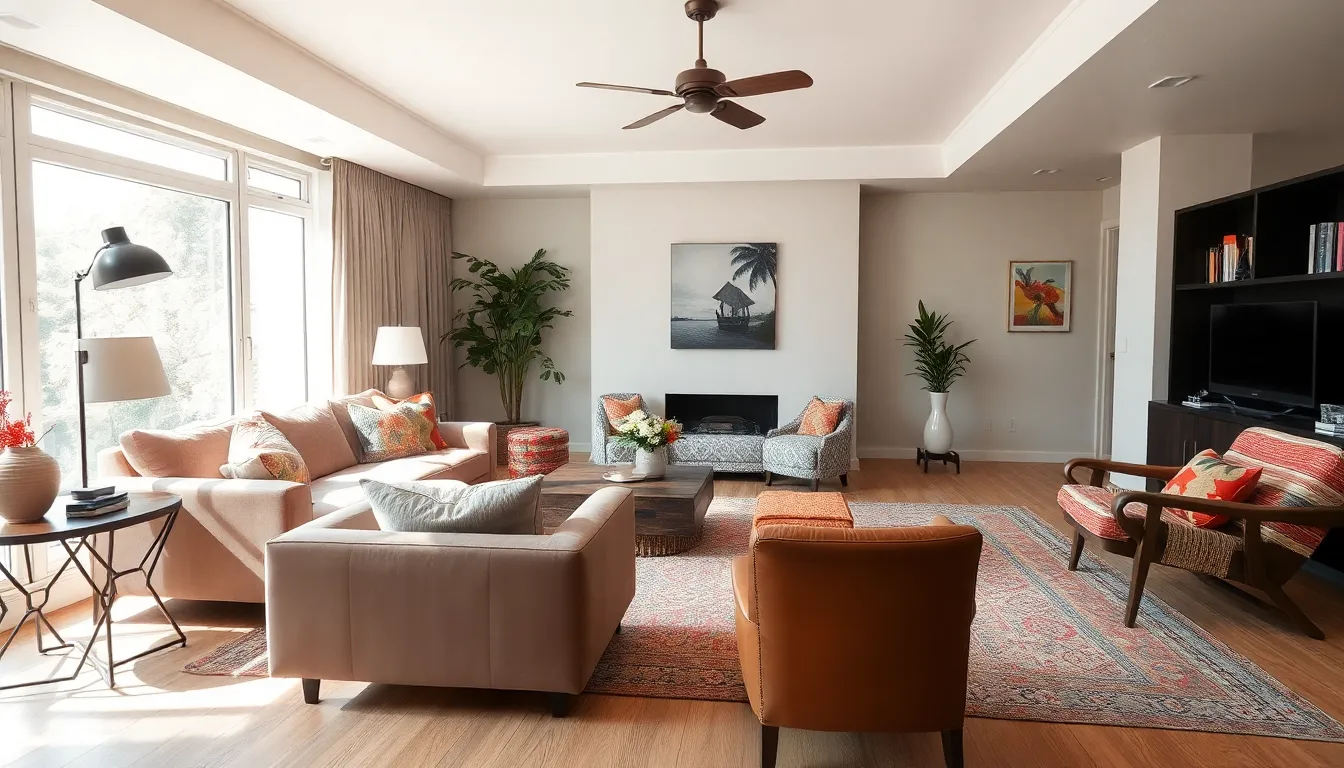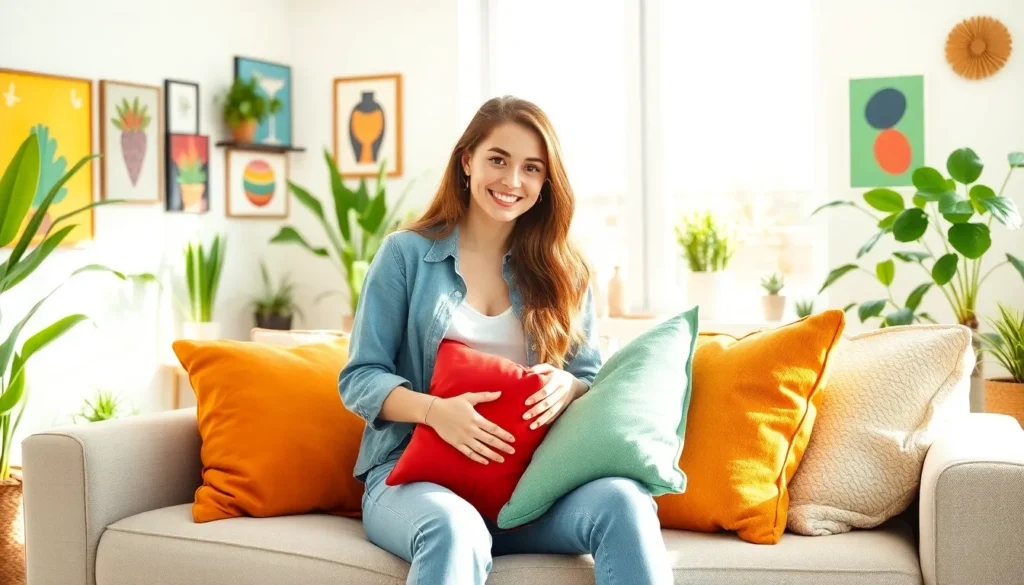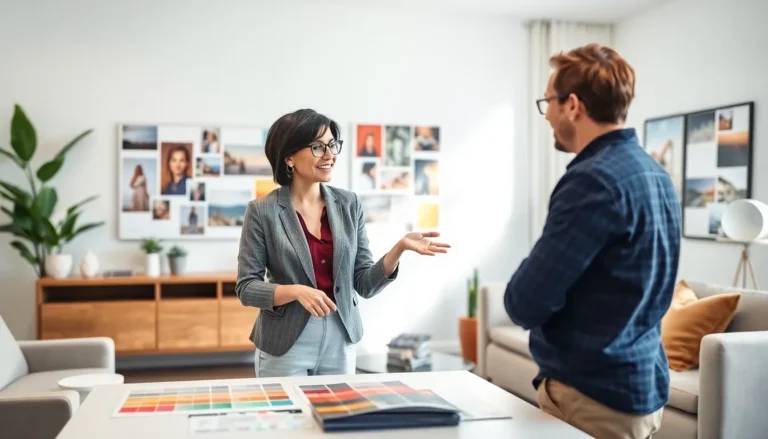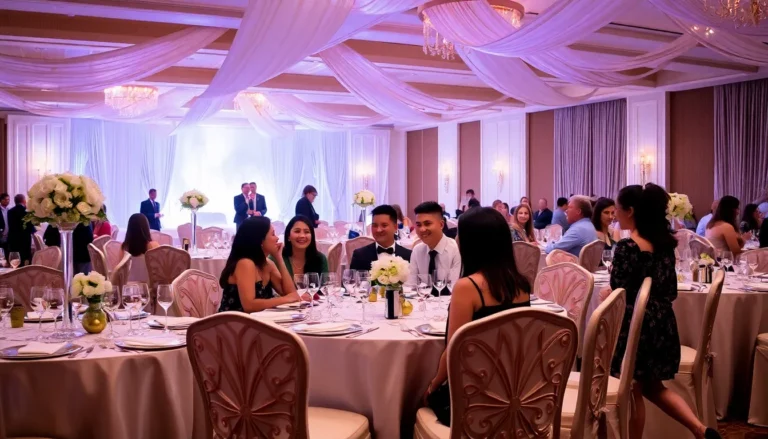Designing and decorating spaces can feel like a daunting task, but it doesn’t have to be! With a splash of creativity and a sprinkle of inspiration, anyone can transform a dull room into a vibrant oasis. Whether it’s a cozy nook or an expansive living area, the right design can elevate a space from “meh” to “wow!”
Imagine walking into a room that feels like a warm hug or an art gallery that sparks joy. That’s the power of thoughtful design and decor. It’s not just about aesthetics; it’s about creating an environment that reflects personality and enhances well-being. So grab your favorite paintbrush and let’s get those creative juices flowing! It’s time to turn those Pinterest dreams into reality and make every corner of your home a masterpiece.
Table of Contents
ToggleUnderstanding Design Principles
Design principles serve as the foundation for effective and appealing decor. They guide choices in color, layout, and overall aesthetic.
Color Theory
Color theory plays a critical role in design decisions. Each color evokes specific emotions and reactions. For example, warm tones like red and orange stimulate energy, while cool tones such as blue and green promote calmness. Understanding color relationships enhances harmony within spaces. Complementary colors, positioned opposite each other on the color wheel, create vibrant contrasts. Analogous colors offer a more serene, cohesive look, lying next to each other. Incorporating these principles helps create desired atmospheres and influences mood effectively.
Balance and Harmony
Balance and harmony ensure visual stability within a design. Several types of balance exist, including symmetrical and asymmetrical options. Symmetrical balance provides a sense of order and formality, while asymmetrical balance fosters interest and dynamism. Harmony is achieved when all elements work together seamlessly. Consistency in color, shape, and texture strengthens this connection. For instance, using similar shapes and colors throughout different decor pieces maintains flow. Prioritizing these principles results in enticing spaces that feel unified and inviting.
Essential Elements of Decor

Decor plays a vital role in enhancing the aesthetic appeal of a space. Focusing on essential elements ensures a cohesive and inviting environment.
Textures and Patterns
Textures enrich visual interest and depth in decor. Incorporating fabrics, such as silk and linen, brings warmth and comfort to spaces. Patterns create a dynamic look, from geometric designs to floral prints, each adding character. Mixing textures and patterns effectively brings a lively ambiance. Consider pairing soft velvet with sleek leather for contrast. Furthermore, layering elements enhances visual complexity. Different textures stimulate touch and provoke emotional responses. Think about utilizing woven textiles, ceramic finishes, or metallic accents to elevate the design.
Furniture and Layout
Furniture selection significantly impacts both function and style. Choosing pieces that complement each other promotes cohesion. Arranging furniture thoughtfully encourages flow and accessibility. Prioritize the scale of items based on room size to prevent overcrowding. For smaller spaces, multifunctional furniture maximizes utility. Creating distinct areas, such as cozy reading nooks or communal gathering spots, fosters comfort. Also, consider the balance between open spaces and filled areas. Clear pathways enhance movement and make the space inviting. Overall, an intentional furniture layout enhances aesthetic appeal and functionality.
Creative Ideas to Create Design and Decor
Exploring creative ideas for design and decor enhances spaces, making them more inviting and personalized. Innovative approaches can inspire anyone to transform their environment.
DIY Decor Projects
Engaging in DIY decor projects provides a hands-on opportunity to personalize space. Crafting unique pieces, like homemade wall art or custom throw pillows, adds a personal touch. Assembling a gallery wall with framed photos creates visual interest and showcases memories. Upcycling old furniture transforms tired items into statement pieces, reflecting individual style. Planting indoor herbs in decorative pots brings life to kitchens while promoting functionality. Each project sparks creativity and encourages an expressive environment that resonates with the homeowner’s personality.
Using Space Wisely
Maximizing space ensures functionality and flow within a room. Opting for multi-functional furniture, such as ottomans with storage or expandable dining tables, increases usability in smaller areas. Arranging furniture to create zones, like reading nooks or workspaces, enhances productivity while maintaining comfort. Clear pathways allow for easy movement, promoting a welcoming atmosphere. Strategically using mirrors can also create an illusion of spaciousness, brightening dark corners. Every choice shapes the space, inviting both practicality and style.
Popular Design Styles
Various design styles serve as inspiration for creating unique and personalized spaces. Understanding these styles helps individuals select decor that aligns with their preferences and lifestyle.
Minimalist Design
Minimalist design prioritizes simplicity and functionality. Featuring a stripped-down aesthetic, it utilizes neutral colors, clean lines, and essential furnishings. Each item holds significance, promoting a clutter-free environment. Natural light enhances this style, creating airy and inviting spaces. For instance, incorporating multi-functional furniture like a sleek coffee table with storage maintains the minimalist ethos. Decorative elements, such as a single striking piece of art or a potted plant, add personality without overwhelming the space.
Bohemian Decor
Bohemian decor embraces eclectic and vibrant expressions of individuality. This style blends colors, patterns, and textures to create warm, inviting environments. Layered textiles, such as patterned rugs and woven throws, contribute to comfort and visual interest. Plants play a vital role, bringing life to any room. Mixing vintage pieces with contemporary items fosters a personalized atmosphere. For example, combining a mid-century chair with a colorful, globally inspired print creates a unique focal point. Overall, bohemian decor encourages creativity and self-expression through its relaxed, free-spirited design approach.
Embracing the art of design and decor opens up endless possibilities for creating spaces that truly reflect individual personalities. By applying essential principles like color theory and balance, anyone can transform their environment into a haven of comfort and style.
The incorporation of textures, patterns, and thoughtful furniture arrangements enhances not only aesthetic appeal but also functionality. Engaging in DIY projects and exploring various design styles allows for personalization that resonates deeply.
Ultimately, it’s about fostering a joyful atmosphere that promotes well-being and creativity. With a little inspiration and effort, anyone can craft inviting spaces that feel uniquely theirs.



